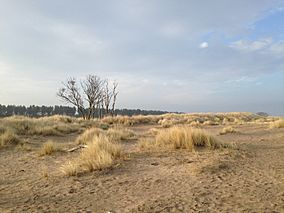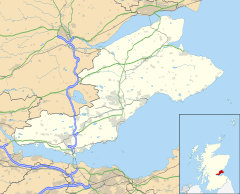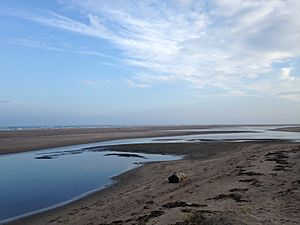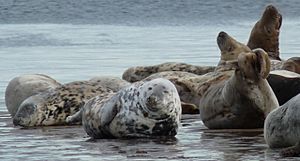Tentsmuir National Nature Reserve facts for kids
Quick facts for kids Tentsmuir National Nature Reserve |
|
|---|---|
|
IUCN Category IV (Habitat/Species Management Area)
|
|

Looking towards Tentsmuir Forest from the coast near Tentsmuir Point
|
|
| Location | Fife, Scotland |
| Area | 564 ha (1,390 acres) |
| Established | 2006 |
| Governing body | NatureScot |
| Tentsmuir NNR | |
Tentsmuir National Nature Reserve (NNR) is a special natural area in Fife, Scotland. It's found southeast of Tayport. This amazing place is looked after by NatureScot.
Tentsmuir NNR is actually made up of three different parts. These parts are Morton Lochs, Tentsmuir Point, and Tayport Heath. Even though they are a bit far apart, they are all connected by a huge system of sand dunes. These areas were first made protected at different times. Morton Lochs became a reserve in 1952, Tentsmuir Point in 1954, and Tayport Heath in 1988. In 2003, all three were joined together to create the Tentsmuir National Nature Reserve we know today. Next to the reserve is Tentsmuir Forest, which is managed by Forestry and Land Scotland.
In October 2020, Tentsmuir was a filming location for the BBC show Autumnwatch. The presenter, Michaela Strachan, spent two weeks there for the programme.
Contents
How Tentsmuir's Coastline Changes
The sand dunes at Tentsmuir NNR are always changing. Some parts of the coast are losing sand, while others are gaining it. A large area of sandbanks and mudflats, called the Abertay Sands, has formed in the last 100 years. This happened because of sand moving around and settling in new places.
Tentsmuir is a very important place to study how beaches and coastlines grow. The area has wide, untouched sand and mudflats. It also has dunes that are growing quickly. You can see all the different stages of sand dune life here. This includes the first plants on the beach, saltmarshes, and "yellow" dunes that are still growing. There are also older, more stable "grey dunes" and areas with lots of lichens. Many special plants and tiny creatures live in these habitats. Some of these species are important for Scotland or even the whole country.
Amazing Plants of Tentsmuir
The different parts of Tentsmuir NNR are home to many kinds of plants. At Tentsmuir Point, over 320 types of plants have been found. Morton Lochs has more than 200 different plant species.
At Morton Lochs, you can find plants like water plantain and yellow flag iris. Other plants that love the wet areas include broad-leaved pondweed and greater pond sedge. The wet forest around Morton Lochs has trees like grey willow, alder, hawthorn, and birch. Even though some land near Morton Lochs was planted with trees in 1954, it still has natural heath plants.
Wildlife at Tentsmuir
The sea near the reserve is home to many common seals. Tentsmuir Point is also a resting spot for grey seals. It's one of the few places where you can see both types of seals together. You might also spot Bottlenose dolphins from the shore. Sometimes, even minke whales and harbour porpoises are seen.
Otters have been seen at Morton Lochs. Finding young otters there suggests that they are successfully raising their families.
Tentsmuir Point is famous for being a key spot for birds that travel long distances. Many waders and wildfowl stop here during their migrations or spend the winter. Between 2004 and 2009, three bird species were found in nationally important numbers. These included eider (11.45% of the UK population), bar-tailed godwit (1.93%), and goosander (1.04%).
The wet areas at Morton Lochs are home to birds like the water rail and the little grebe. You can also see tufted ducks and goldeneyes. Ospreys visit Morton Lochs, as well as the rare marsh harrier.
The sand dunes at Tentsmuir NNR have a huge variety of tiny creatures. There are 46 species of invertebrates that are rare or scarce across the whole country.
Why Tentsmuir is Protected
Tentsmuir National Nature Reserve is a Category IV protected area. This means it's a special place managed mainly for saving wildlife and habitats. It's protected by the International Union for the Conservation of Nature.
Besides being an NNR, Tentsmuir is part of other important protected areas. These areas stretch along the coast of the Firth of Tay and the Eden Estuary. This wider area is known as a Special Area of Conservation (SAC) and a Special Protection Area (SPA). It's also a Ramsar Wetland of International Importance, which means it's a very important wetland globally.
The NNR also includes parts of two Sites of Special Scientific Interest (SSSI). Part of the Tentsmuir Coast SSSI and all of Morton Lochs SSSI are within the reserve.




